Field Review: Retra LSD Prime snoot
MORE THAN SPOTLIGHTS.
The ability to change the shape of the light is an important feature of the LSD and a strong selling point. But it is important, as underwater photographers, we do not get to caught up believing that macro spotlighting (whatever the shape of the spotlight) is the only use of snoots. It is an easy trap to fall into when the LSD Prime is supplied with 13 different and alluring shapes.
I accept that it is often important in competition photography to show our working to the judges. If you have been clever with a technique you want to the judges to know it! But away from competitive photography, I believe that the great strengths of using a snoot are for more subtle shots.
A prime example is to be able to light a subject entirely, but not its surroundings. In other words, to create a high impact portrait of a creature, framed against a clean black background, even when it is a creature that never typically poses so obligingly in mid-water. The resulting image may just be a standard looking image, but it is a far stronger image than would have been possible with normal illumination give the opportunity. This is something the LSD excels at too.
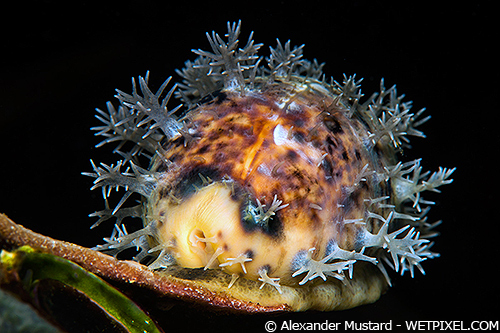
For this type of image it is best to use the snoot on camera, centrally positioned above the port (for horizontal shots) and angled to light the subject and not the background. I usually take a minute or so to get the snoot approximately aimed at the beginning of the dive on a boring subject like a rock. Then I switch my focus to the AF-ON button (AKA back focus), so that the camera no longer focuses unless I tell it and I know that if the subject is in focus it is also in the light. Of course, the LSD snoots are designed to channel the aiming light of your strobe, which greatly helps when making small adjustments to strobe positioning. When making these small changes, I tend to adjust the snoot first, then hit AF-ON to refocus. However, I try and keep adjustments to a minimum. It is much better to look for several subjects of a similar size and orientation rather than constantly rejigging my system.
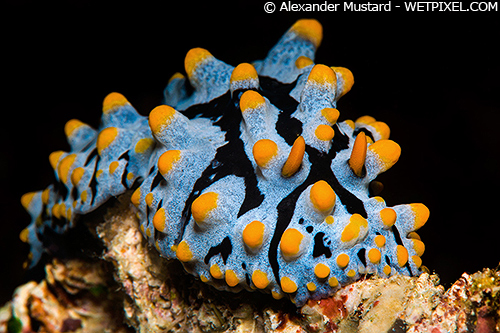
The LSD snoots produce strongly directional light, which it particularly suited for side lighting subjects and picking out texture. Using the strobe’s aiming light as guide it is quite easy to side light non-moving subjects and create simple, yet interesting images. Again I use a similar technique for these shots, of getting the lighting positioned correctly and the switching the AF activation to AF-ON only, so that when the camera is in focus, the lighting is correctly positioned. I’ll also hunt around for a range of subjects to shoot with this style of lighting before readjusting for another type of image.
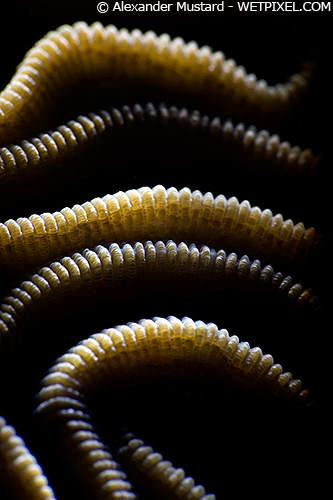
Backlighting has always been an excellent way to create very different types of images of familiar subjects. This effect can be easily achieved with on-camera strobes, providing your strobe arms are long enough to reach round behind the subject. But it is often easier to set up with off-camera strobes. Of the two examples below, the rim-lighting on the fire coral was with an on camera strobe and the x-ray lighting on the waspish was with an off camera strobe.
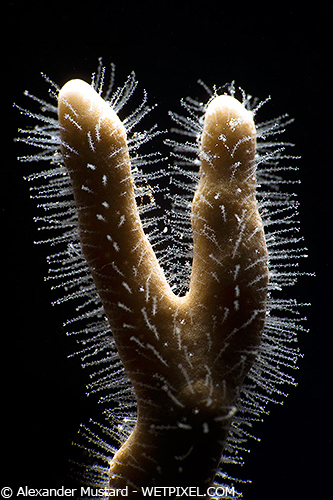
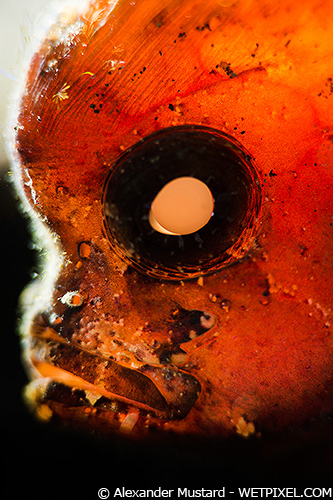
Many photographers struggle with backlighting because they are fooled by the name, thinking “to back light a subject, the strobe must be completely behind it”. This is incorrect. To achieve backlighting the back of the subject must be lit, but the source of the light should be outside the frame (in other words, off to one side, not directly behind it). The LSD is highly suited to this as it creates a narrow beam of light, which can be precisely aimed at the subject, to create the backlighting effect, while minimizing backscatter and keeping the source of the light hidden. If the subject is large enough to completely hide the light source, we can place the strobe directly behind it.
It is also worth mentioning that another popular use of the LSD for competition photographers is to create in camera double exposures, placing a macro subject low in the frame and a wide angle background in the top of the frame, you can read more about this technique here on my website. As I am sure you will have realized, the LSD snoot is ideally suited to creating the foregrounds for double exposures, enabling you to generate a black background even in bright conditions.
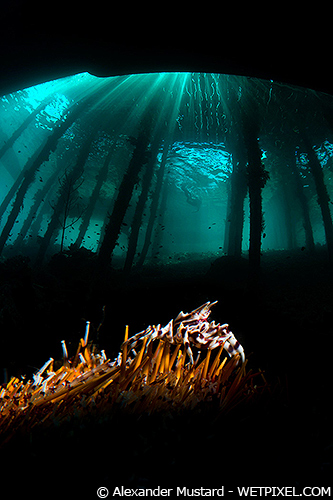
THOUGHTS ON STROBES.
The LSD can be used either on a strobe mounted on-camera or off-camera. Both techniques are suited to certain types of lighting and subjects. For on-camera strobes, it is important to dive with long enough strobe arms to give you plenty of flexibility for aiming, but it is important not to waste your dive constantly moving the strobe. Find a position that works for a type of lighting and shoot a few different subjects before changing.
Off-camera use is in many ways simpler, certainly with a stationary subject on the sand, where there are plenty of places to position the strobe’s tripod. First aim the strobe and then you have flexibility to try several different camera angles, not worrying about the effect on the lighting.
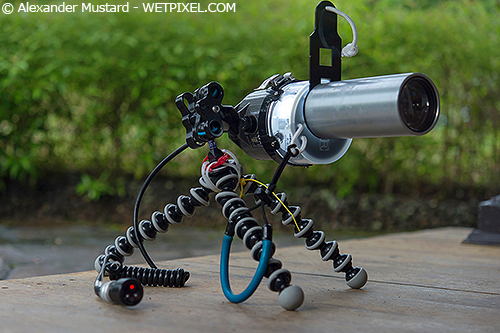
The main equipment you need for off camera strobe work are a tripod (I use a plastic Gorillapod-SLR) with a mounting ball, so you can clamp the strobe to it. To trigger the strobe, you can often just get away with the strobes own optical sensor, for this type of shooting. However, here I am using a cable and Triggerfish slave sensor for more control.
Retra make both the Prime and Pro versions of the LSD for all the commonly used strobes. I am often asked if there is an ideal strobe for snoot photography. The bad news is no, the good news is that Retra’s LSDs are designed to work with all strobes. To explain, the best type of flash tubes for snoot photography are small ones, which create a concentrated source of light. However, to help aiming the LSD, it is easiest with a central strobe aiming light. And strobes with small flash tubes (INON Z240, S2000 and Sea & Sea D1) don’t have central focus lights. And strobes with central focus lights (Ikelite, Subtronic, Seacam) don’t have small flash tubes.
I took the LSD to Lembeh and ran into (what is the collective noun for photographers?) an album of photographers of NAD-Lembeh Resort from the Underwater Macro Photographers group. Looking around the resort it was quickly obvious that Japanese strobes dominate the market, with INONs and some Sea & Seas on all the rigs. Therefore it is important to many photographers that the LSD Prime works well on INON strobes. However, the ubiquitous INON Z240 is one of the more troublesome brands to deal with because the aiming light is considerably off-centre.
For the LSD Pro, Retra make an dog-legged EPL module that centers the INON aiming light on the intake for the LSD. On the cheaper LSD Prime, their solution is to move the intake away from the centre, so it still collects much of the power from the strobes, but also collects part of the Z240’s aiming light. This solution works, but it is not ideal because while the spotlight created by the aiming light gives a guide of where the snoot will light when the flash fires, it does not show the whole area. This is a frustration on your first dive with the unit, but is something you will quickly adapt to. Do note that this is only an issue on strobes without central aiming light.

CONCLUSION.
Most people find their first few dives working with snoots very frustrating, so if you purchase one of Retra’s products, do give yourself 5 dives without before putting pressure on yourself to produce results.
Both the LSD Pro and Prime are very well made products and certainly demonstrate the advantages of an optical snoot. The new LSD Prime offers almost all of the performance of the LSD Pro at a much lower price point and comes with even more aperture masks for shaping the beam. The main advantages of the LSD over a simple funnel snoot are the greater working distance for small spots of lighting, the much greater efficiency allowing small apertures and therefore black background shots to be made in daylight and the ability to shape the beam. Furthermore with most strobes the LSDs can use the strobe’s aiming light to accurately show you what the strobe will illuminate before your shoot.
Although both units are expensive, I believe the price of each feels fully justified when you experience the quality and performance of the product. Furthermore, it is important to remember that the LSD can produce many types of lighting. Many photographers are focused on macro spotlights, but the snoot is well suited to creating directional side lighting and both rim and x-ray backlight. And, while I have not covered it in this review, the LSD is also well suited to backlighting and spotlighting in wide angle images. The LSD can be easily clipped on and off a strobe during a dive.
But personally I found it most exciting for simply being able to control what I lit and didn’t light within a scene. While I think that spotlighting subjects can feel overly contrived outside of competition shooting, I think that the ability to subtly light a subject and not the background is a very powerful benefit of the LSD for everyday photography. I was also drawn to the very directional quality of light and strong shadows that the collimated beam produced and this is something I look forward to experimenting more with in the future.
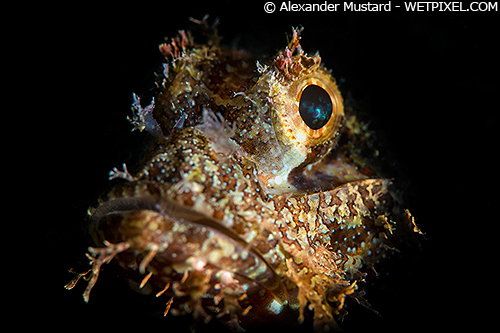
In conclusion, a snoot is a valuable and versatile addition to any underwater photographers armory of techniques. And it is hard to think of a finer example on the market than Retra’s LSD Pro and LSD Prime.